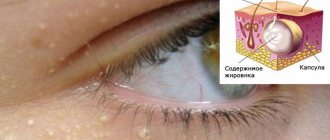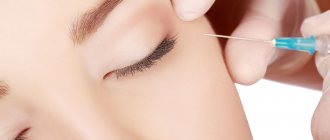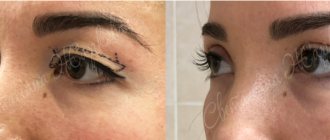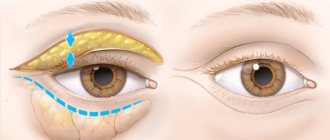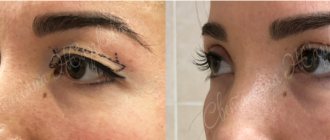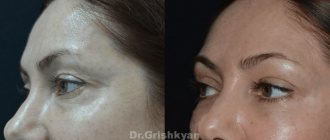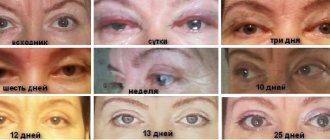Causes Symptoms of eyelid ectropion Diagnosis Treatment of eyelid ectropion Advantages of treatment of eyelid ectropion in MGK Price Video
Eversion of the eyelid (synonymous with “ectropion”) is a pathology in which the edge of the eyelid does not adhere to the surface of the eyeball, which is why the palpebral fissure remains partially open.
The consequence of eversion of the eyelid is drying out of the mucous membrane of the eye, which contributes to its mechanical irritation and can cause chronic inflammation.
Causes
Depending on the reason that caused the appearance of eyelid inversion, the following forms of ectropion are distinguished:
Senile eversion of the eyelid – occurs in elderly patients and is caused by weakening of the orbicularis oculi muscle
Cicatricial eversion of the eyelid can occur after injuries (wounds, burns) or operations (blepharoplasty), as well as in people with systemic connective tissue diseases (systemic lupus erythematosus)
Spastic eversion of the eyelid is a consequence of excessive tension of part of the fibers of the orbicularis oculi muscle.
Paralytic eversion of the eyelid is caused by paralysis or paresis of the branches of the facial nerve
“ROUND EYES” EFFECT
The most common mistake that an inexperienced surgeon can make when performing blepharoplasty is to excise too much skin of the lower eyelid. As a result, the so-called “round eye effect” occurs: the eyes look unnaturally bulging, and in the worst case, they do not even close completely. Needless to say, such an effect not only completely spoils the impression of the operation, but also significantly complicates the patient’s life.
Such patients develop watery eyes, dryness and redness of the eyes, and conjunctivitis often occurs. The eyes have an unnatural, “operated” appearance.
Treatment of ectropion
To alleviate the patient's condition and temporarily eliminate the symptoms of eye irritation, moisturizing drops (such as artificial tears) are used.
Often, eyelid inversion requires surgical treatment. The exception is spastic eversion of the eyelid, in which it is possible to prescribe drug therapy, the purpose of which is to eliminate spasm of the orbicularis oculi muscle.
Surgical treatment of ectropion is aimed at eliminating the cause that caused the appearance of eyelid inversion. If an inversion occurs due to shortening of the skin of the eyelid (surgery, trauma, scar), the patient may need a skin flap transplant to replace the existing defect.
What is eversion and entropion of the eyelids?
Eversion of the eyelids (ectropion) is a pathology in which the edge of the lower eyelid is turned down, and the mucous membrane, which should be adjacent to the eye, is turned outward.
At the same time, the delicate mucous membrane of the eye is not moisturized, it comes into contact with the external environment, and because of this it becomes susceptible to inflammation and infections. Entropion (entropion) is a pathology in which the ciliary edge of the lower eyelid is turned inward and constantly injures and scratches the membrane of the eye - the cornea, reducing the patient's visual acuity and causing pain. Chronic trauma to this membrane of the eye leads to inflammation.
Advantages of treatment of eyelid eversion in the MGK
A good outcome in the treatment of eyelid inversion depends on a combination of several factors: timely and complete diagnosis of the disease, selection of the most effective treatment method, regular monitoring and proper management of the postoperative period. All patients of the Moscow Eye Clinic receive all these benefits.
An individual approach and attentive attitude towards patients is the key to effective treatment of any eye diseases at the Moscow City Hospital. Thanks to modern diagnostic equipment, the examination takes a minimum of time. Based on the examination results, our doctors will recommend a suitable treatment method and answer all your questions.
The clinic sees some of the best specialists in the capital, who have thousands of successful operations behind them. Their practical experience and theoretical training allow them to achieve the best treatment results even in the most difficult cases.
Our clinic is open seven days a week, from 9 a.m. to 9 p.m., seven days a week. For the convenience of patients, there is a day hospital where every patient can receive help.
If you are interested in questions, you can ask specialists by calling 8 and (499) 322-36-36 or online using the appropriate form on the website.
Author:
Dagaev Adam Huseinovich 5/5 (1 rating)
Honey. portal:
REPEATED BLEPHAROPLASTY
However, there is no need to panic in any of these cases. If you have undergone blepharoplasty and it was unsuccessful, in any modern clinic you will be offered a repeat operation. Repeated intervention will help correct inaccuracies made during the initial procedure and provide the result that you originally expected.
The only difficulty is to find a specialist whom you really trust. Because after an unsuccessful operation, patients are usually afraid of repeated failure. Collect information about different clinics, look at reviews of the work of the most famous surgeons, talk with friends who have undergone plastic surgery and are satisfied with the result.
On the website in the appropriate section you can find real patient stories with attached photographs before and after the procedure. And, of course, the surgeon himself will help to fully clarify the situation during an individual consultation.
RESULT OF BLEPHAROPLASTY
Correction of the eyelids instantly transforms the appearance: the look becomes open and youthful, swelling, bags under the eyes, wrinkles, and sagging eyelids disappear. The result of the operation lasts for many years; recommendations for care and consolidation of the effect will be given by specialists from the Cosmetology Department of the N. I. Pirogov Clinic. For a quick recovery, cosmetologists select a program, after which you can quickly enjoy the result of the operation and demonstrate it to others.
Treatment
The type of treatment for ectropion is chosen by the doctor depending on the cause of the disease and its severity. Typically, all types of treatment for ectropion come down to the following methods:
- eliminating the cause of the pathology;
- symptomatic therapy;
- surgical treatment.
When surgery is not needed
Ectropion is not always treated promptly. In some cases, conservative treatment is sufficient. Indications for such therapy are cases when:
- symptoms are mild;
- there are contraindications for surgical treatment (age, drug intolerance, disease);
- It is enough to eliminate the cause of the disease (tumors, paresis of the facial nerve, etc.), and ectropion will go away on its own.
The usual practice of ectropion therapy is the prescription of procedures and medications that help alleviate the patient’s condition and avoid complications of the disease (conjunctivitis, corneal ulceration, etc.). With this method of treatment, the following methods are often used:
- using a special patch at night to facilitate closing the eyes (if not closed);
- inclusion of drugs to moisturize the mucous membrane of the eyeball (usually such as artificial tears) for instillation several times a day;
- stitching the edges of the eyelids to protect them from drying out (in severe cases of the disease).
Surgical treatment of eyelid inversion
Surgical treatment is indicated mainly for the following types of ectropion:
- senile;
- cicatricial;
- mechanical (after getting rid of the tumor that caused the eyelid change).
The surgical technique is selected taking into account the patient’s age, the condition of the body and eye tissues.
The main points are:
- the reason for this inversion;
- the presence of scars;
- the degree of elasticity of the ligaments supporting the corners of the eyes.
- condition of soft tissues, their excess or deficiency (after blepharoplasty for the purpose of rejuvenation).
Surgery for ectropion is always performed by an ophthalmologist or plastic surgeon.
The essence of the operation for ectropion is to return the deformed eyelid to the correct position and fix it.
Before the operation, the patient needs to consult a surgeon and conduct a number of studies:
- blood (general, coagulation and biochemical analysis);
- urine (general analysis);
- ECG;
- chest x-ray.
Typically, surgery for ectropion is performed under general anesthesia, so before the intervention you need to consult an anesthesiologist.
Sometimes consultations with doctors of other specialties and additional tests may also be necessary.
Surgery for ectropion
The operation for eversion of the eyelid lasts from one to three hours, depending on the complexity and technique used. In addition to correcting the external defect, this operation normalizes the process of tear drainage and eliminates the cosmetic consequences of ectropion (hernias and excess skin are removed from the eyelids, the outer corners of the eyes are raised). Such additional points are clarified in advance if the operation is performed by a plastic surgeon.
Incisions in such operations are placed in natural folds of the skin using a cosmetic suture. Subsequently, postoperative scars are completely invisible.
For several weeks after the intervention, hematomas and swelling of the eyelids and parts of the face will persist. Already in the first hours after surgery, cooling compresses are used to reduce swelling.
We advise you to read: PTOZ can develop under the influence of many reasons and is a cosmetic defect that can be treated therapeutically.
Inpatient observation is required on the first day of the postoperative period.
After discharge, patients are scheduled to visit the attending physician to monitor the tissue healing process.
Physiotherapeutic procedures (usually in combination with proteolytic enzymes) are often used to speed up postoperative recovery and resolve scars.
Contraindications for surgery
Surgical treatment of ectropion has its contraindications. It is often impossible to use surgery for ectropion in older people. Also, such contraindications may be serious pathologies associated with:
- diseases of the heart and blood vessels;
- hypertension with frequent crises;
- complicated by diabetes mellitus;
- severe thyroid diseases;
- retinal detachment;
- dry eye syndrome.
Negative consequences of the operation
Sometimes it is not possible to completely eliminate the defect with ectropion. And after the operation itself, a narrow gap remains between the eyeball and the edge of the eyelid. As a result, the risk of re-development of the eyelid gate remains high.
Common postoperative complications with this disease may also include manifestations associated with:
- wound infection;
- divergence of seams;
- bleeding from a postoperative wound;
- the appearance of cysts in the epidermis;
- dysfunction of the lacrimal glands;
- blepharoptosis (drooping of the upper eyelid);
- lagophthalmos (inability to close the eye).
An unpleasant surprise for patients is that to eliminate all of the above complications, they often have to undergo a second operation.
Memo for the patient after ectropion surgery
To minimize the risk of complications after ectropion surgery, the patient during the recovery period is usually advised to:
- refusal of any visits to baths, saunas and generally thermal procedures on the face for 2 weeks (to reduce swelling and bruises);
- limiting any physical activity and avoiding bending for 1 month (for successful resorption of swelling and tissue restoration);
- protection from direct sunlight to the eyes (including avoiding visiting a solarium) for 6 months (to prevent the appearance of unnecessary pigmentation on the eye).
Any eye disease should alert you. The visual organ is not only extremely important for a full life, but also requires special attention: “Take care of your eye like a diamond!” Eversion of the eyelid is not only a cosmetic defect, but also provokes many visual disturbances. For effective treatment of this disease, it is especially important to correctly determine the cause of its occurrence. Often, to eliminate this eye pathology, surgical treatment is required, after which it is important to comply with certain restrictions. A professionally performed operation helps eliminate all symptoms of eyelid inversion and avoid its various complications. Take care of your eyes!
Sources used:
- Secrets of people who see well / Oleg Pankov. - M.: AST, 2014.
- Skoromets A. A. Topical diagnosis of diseases of the nervous system: A guide for doctors. — 1st ed. - L.: Medicine, 1989
- How to restore vision without surgery / Marina Ilyinskaya. - M.: Eksmo, 2016.
- National Eye Institute
Symptoms
When the eyelid is everted, the patient complains of:
- lacrimation, causing irritation and maceration of the skin around the eye,
- conjunctivitis, keratitis, accompanied by redness and pain.
When an eyelid turns in, the following symptoms may occur:
- pain and inflammation due to trauma to the cornea by the ciliary edge,
- with prolonged absence of treatment - clouding of the cornea as a result of chronic inflammation,
- conjunctivitis, keratitis.
How is blepharoplasty surgery performed?
Duration of circular blepharoplasty – up to 1.5 hours
.
The operation takes place under local or general anesthesia. The plastic surgeon makes incisions in the natural folds of the skin of the upper eyelid and under the eyelash line (when correcting the lower eyelids). This provides access to the subcutaneous fatty tissue. After removing excess skin and fat, the surgeon applies stitches and a special bandage, which is removed 30 minutes after the operation. The length of hospitalization
after blepharoplasty ranges from 6 hours (in a day hospital) to 1 day in a ward, after which we discharge patients home.
The cost of repeated blepharoplasty at the Doctor Grishkyan plastic surgery clinic in Moscow.
Blepharoplasty (eyelid surgery) cost of surgery
| Operation name | Cost in rubles |
| Upper eyelid surgery | 160000 |
| Lower eyelid surgery | 160000 |
| Blepharoplasty of the upper and lower eyelids | 250000 |
| Volume plastic surgery of the upper eyelids (upper eyelid surgery + lipofilling) | 180000 |
| Volume plastic surgery of the lower eyelids (Lower eyelid surgery + lipofilling) | 180000 |
| Transconjunctival blepharoplasty of the lower eyelids (author's technique) | 180000 |
| Repeated blepharoplasty of the upper eyelids, correction of complications after eyelid surgery by another surgeon | 210 000 |
| Repeated lower eyelid blepharoplasty, correction of complications after eyelid surgery by another surgeon | 210 000 |
Why do age-related changes appear again after successful blepharoplasty?
Sometimes, after a certain period of time (usually 6 to 7 years), age takes its toll again. Even the most qualified and talented plastic surgeon is not able to stop the aging process and to maintain a young, attractive image, repeated use of the scalpel is necessary.
The patient underwent repeated blepharoplasty of the upper eyelid and lipofilling after previously performed eyelid surgery, which did not satisfy her.
Go to photo gallery
It is important to consider one more point. Plastic surgery does not stand still. It is developing very actively, new technologies, methods and materials are appearing. For example, the patient was not satisfied with the result of plastic surgery, which was performed several years ago. At that time, now outdated methods were used. In this case, repeated blepharoplasty in a modern modification can provide a much better aesthetic result. So, before, blepharoplasty involved radical excision of skin and fatty hernias. Whereas, at the moment, experts strive to preserve and replace fatty tissue in the periorbital region as much as possible. This is important because fat cells are responsible for youth and skin turgor.
Just five to seven years ago, unsuccessfully performed blepharoplasty could provoke sunken eyes, skeletonization, rounding of the eyelid, as well as the appearance of other problems. Now these risks are practically reduced to zero. All this became possible thanks to modern eyelid rejuvenation techniques. Today we harmoniously combine conservative tissue excision and lipofilling. Repeated blepharoplasty can correct the negative results of primary eyelid surgery, as well as significantly IMPROVE its aesthetic result.
Recovery after blepharoplasty
The patient can return to normal life the very next day after the operation; it is important to follow the recommendations of the plastic surgeon: apply ice at first, avoid ultraviolet radiation at high temperatures, and intense physical activity. Pain is usually not expressed. Stitches are removed within 4-6 days
after surgery, examined by a doctor. Bruises disappear within 14 days. You can speed up recovery and make it more comfortable with the help of a course developed by our plastic surgeons and cosmetologists.
Complications during blepharoplasty and methods for their correction
Repeated blepharoplasty - lipofilling of the upper eyelid was performed in order to recreate the mendala-shaped eye shape lost after blepharoplasty.
An unsuccessful surgical intervention entails disappointment and dissatisfaction for the patient. Negative aesthetic results and varying degrees of complications of blepharoplasty completely negate the original goal of rejuvenating eyelid surgery. The problems that arise after unsuccessful lower and upper blepharoplasty differ radically.
Complications after upper eyelid blepharoplasty
When performing upper eyelid surgery, the surgeon makes an incision at the level of the skin fold of the upper eyelid. Thus, to hide the scar in the natural crease of the eyelid. What is important is that she remains invisible to the gaze of others. The operation involves excision of excess fat on the upper eyelid, straightening and removal of fatty hernias. Among the most common complications of upper eyelid blepharoplasty, experts note:
- Excessive excision of skin. In most patients, the skin stretches spontaneously after a short period of time. In some cases, the patient is prescribed injections of a special drug that provokes stretching;
- Insufficient skin excision. In this case, there is no way to do without a repeat operation to remove excess skin tissue;
- Excessive removal of fatty tissue (so-called fatty hernias). The error entails a complication in the form of skeletonization of the upper eyelids. The deficiency can be corrected using the lipofilling method.
Complications after lower eyelid blepharoplasty
A complication in this case is excessive removal of fatty tissue (hernias) during the first blepharoplasty.
Ptosis (the lower eyelid is excessively taut downwards). This complication of lower eyelid blepharoplasty occurs due to excessive removal of skin under the eyes. The correction can be carried out in two ways. The surgical method involves performing canthopexy (its goal is to strengthen the outer edges of the lower eyelids). To improve the aesthetic effect, our specialists usually complement this operation with lipofilling of the outer corners of the eyes, which creates a supportive cushion. The second method is medicinal, when the skin is stretched using special drugs. Elimination of the defect using medications. Treatment can begin no earlier than 6 months after unsuccessful blepharoplasty.
Causes and symptoms of ectropion
Eversion of the eyelid occurs for the same reasons as entropion. There are ectropion senile, congenital, spastic, cicatricial, tumor, paralytic. The symptoms of these diseases are also not very different. With ectropion, there is inversion of the lower eyelids and symptoms such as:
- Tearing. The punctum, which is located on the lower eyelid, moves away from the eyeball and becomes exposed, causing tears to drain rather than be distributed throughout the conjunctiva.
- Sensation of “sand” in the eyes. The tear fluid does not reach the surface of the eye, which causes the connective membrane to dry out. Irritation, inflammation, itching, burning occur.
- Hyperemia of the eyelid margin and conjunctiva. Trying to get rid of itching and watery eyes, a person rubs his eyes with his hands and a handkerchief, which causes redness.
- Wet softening of the eyelids, or maceration. Due to constant lacrimation, the skin swells and loses elasticity.
- Inflammation of the cornea, or keratitis. Dryness provokes the appearance of ulcers on the cornea and the development of inflammatory processes. When it is damaged, visual acuity decreases.
